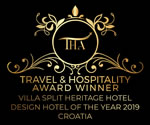Diocletian Palace
Diocletian Palace is one of the best preserved monuments of the Roman architecture in the world. The Emperor’s Palace was built as a combination of a luxury villa – summer house and a Roman military camp (castrum), divided into four parts with two main streets. Southern part of the Palace was, in this scheme, intended for the Emperor’s apartment and appropriate governmental and religious ceremonies, while the north part was for the Imperial guard – the military, servants, storage etc. The Palace is a rectangular building (approximately 215 x 180 meters) with four large towers at the corners, doors on each of the four sides and four small towers on the walls. The lower part of the walls has no openings, while the upper floor is open with a monumental porch on the south and halls with grand arch windows on the other three sides. Over the centuries the Palace inhabitants, and later also the citizens of Split adapted parts of the palace for their own requirements, thus the inside buildings as well as the exterior walls with the towers significantly changed the original appearance, but the outlines of the Imperial Palace are still very visible.
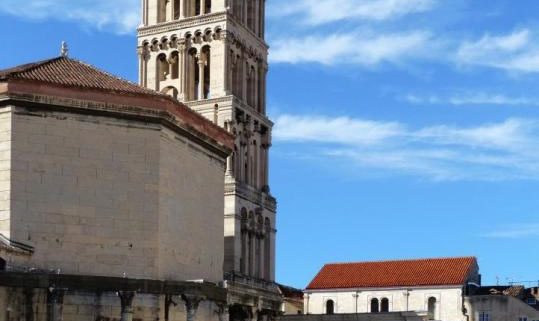
Cathedral of Saint Domnius
Among the European cathedrals the one in Split finds its seat in the oldest building – the Mausoleum of the Roman Emperor Diocletian. Inside the cathedral, at the end of the second millennium, the history reconciles ancient pagan, Christian Medieval and modern heritage. Mausoleum of the Emperor – persecutor of Christians becomes a cathedral in the 7th century where altars with relics of St Domnius and St Anastasius, martyrs executed in the nearby Solin, take an honorary place.
Outer octagon of the mausoleum is enclosed by an aisle (peripter) formed of 24 columns. In its interior it has a circular form with four semicircular and four rectangular niches. In the middle stood the Diocletian’s sarcophagus, later destroyed. Above the niches rise eight red granite Corinthian pillars, and above them another eight smaller ones.
The cornice circling above shows a relief of erots hunting, masks and human heads. Two medallions with bows are specially interesting as the archaeologists and Split’s tradition recognise in them the portraits of Emperor Diocletian and his wife Prisca.
Of particular interest is also the construction of the cupola with its fan-like arrangement of bricks in the lower part and a circular arrangement in its upper third. The cupola gleamed with glittering mosaics just like the one in the Vestibule.

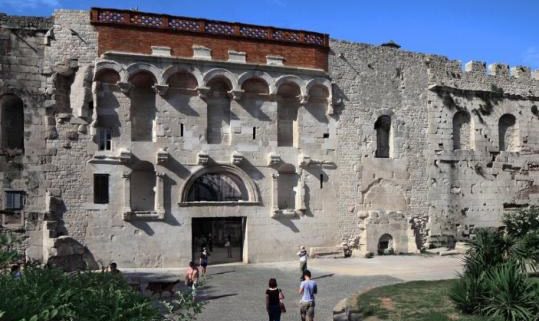
The Golden Gate
Porta septemtrionalis is their Roman name. Emperor Diocletian walked through them as he entered the Palace on the 1st of June 305. They were built in the shape of a rectangle, with double doors, as part of the defensive military tactics (propugnaculum).
The facade was decorated with niches containing figure sculptures of the four tetrarchs (Diocletian, Maximian, Galerius and Constantius Chlorus). These doors, starting from Peristyle, and then through Cardo street, led directly towards Salona as the capital city of the Roman Province Dalmatia, and could only be used by the emperor and the members of his family. Today they are, together with the nearby monument to the Bishop Gregius of Nin (Grgur Ninski), the work of a great Croatian sculptor Ivan Meštrović, one of the favourite Split tourist spots.
Under the influence of Venice, in the 16th century, the gates change their name to Porta Aurea or Golden Gates, and this name stayed with them to this day.

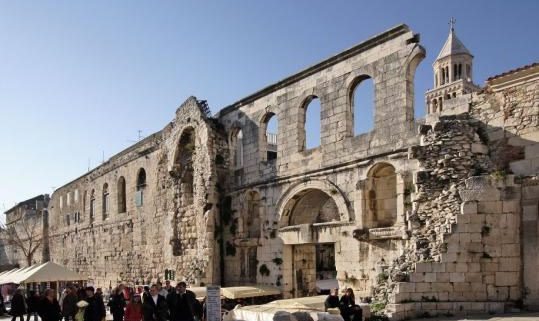
The Silver Gate
Porta orientalis is their Roman name. These gates were used to enter the palace from the east towards the west, through the main street, decumanus, all the way to the Iron Gate and to Pjaca, the central city square.
The Silver Gate was more modest in its decorations than the Golden one, and it was closed from the Middle Ages till 1952, only to be thoroughly reconstructed during the destruction of the Baroque church Dušica. On each side of the gate the remains of the octagonal towers are visible, hence making it easy to imagine the beauty of the construction and the strength of the control over the entrances from the north, east and west. Entering through those gates the passersby, even today, have the opportunity to walk the original ancient pavement on decumanus, walked also, so many years ago, by the Diocletians subjects.
Silver Gate has recently enriched its history with the greatest event for all the Split Catholics, when in the year 2000 Pope John Paul II passed through them admiring the beauty of St Domniuses Cathedral where he later prayed.

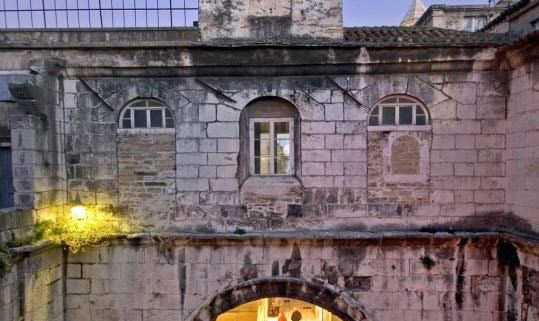
The Iron Gate
Their original, Roman name was PORTA OCCIDENTALIS, and they are one of the four through which life flowed during all 17 centuries of the history of Split. From the very first day that they were opened, they continued to witness all the changes the city went through from the Roman times, through the middle ages till today, all the power and influences, only to welcome, even to this day, with the bells of the Renaissance clock, the city of Split with its citizens. A relief of Nika, the Roman Goddess of Victory stood on the lintel, but already in the fifth century the Christians carved a cross in its place as their symbol.
In the eleventh century, a small church of our Lady of the Belfry, was built above the door, originally dedicated to St Theodor, with beautiful early Romanesque bell tower. In the Middle Ages the area inside the gate was used as a courthouse, and until about fifty years ago an empire of small shops found its place there.
This entire history dynamics is present to this day, with housing construction in the very walls of the gate, bell tower, part of the Roman guards pathway with a wonderful view of the decumanus and the People’s Square (Narodni trg), and also city clock which is of a special interest as it has 24 digits instead of the usual 12. By the very door one of the most beautiful Palaces of the late Split noblemen found its place, belonging to the family Cypriani Benedetti, decorated by two unique six-arch windows.

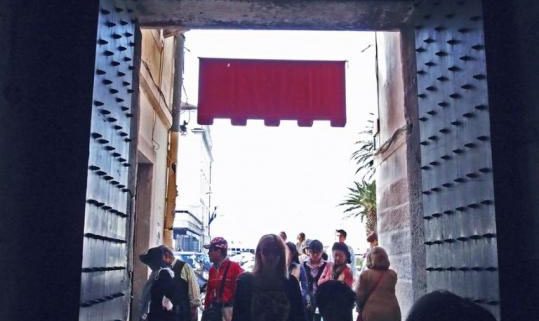
The Brass Gate
PORTA MERIDIONALIS is their Roman name. As the gate which, under some assumptions of the original state of the south facade of the Diocletian palace – the sea mourned, differs completely to the other three. Modest in size, but also different in its function as it leads through the Substructures directly to the sea.
Besides its Renaissance name Aanea – Brass, it also earned the attribute Secure, as it ensured the possibility of a flee by the sea in case of attack on the Palace from the mainland. With a partial restoration, authentic door blocks indicate to the surprised visitors soon to be a two millennium old water resistance. Today they became the “main” gate as the tourists pass through them most frequently to start their guided tours with local guides, and arrive through the Substructures to the central part of the Palace.

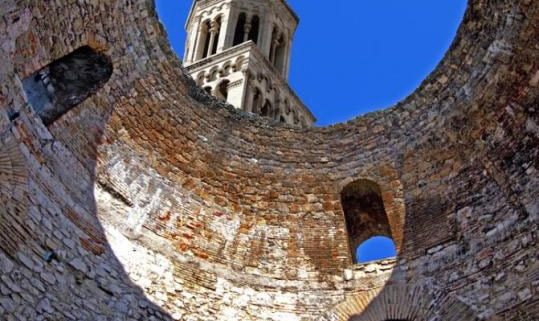
Vestibule
From the outside rectangular, and from the inside circular ground plan of this old imperial court, Vestibule leaves a monumental impression even to this day. And how fascinating was it in its original entirety: semicircular niches with statues; a large cupola with colourful glittery mosaic, witnessed by Marko Marulić in his manuscript from the 16th century; the whiteness of the round wall. Vestibule was used to enter the residential part of the palace. But can you imagine that little over half a century ago it was used for living, and that the residents kept poultry there and cultivated gardens?
Southeast of the Vestibule is the mediaeval part of the city, with the oldest early Romanesque house from the tenth century. It leans on the very Vestibule, and in it today is one of the most beautiful and most awarded Split hotels, conveniently named Vestibule. On the other side of the square, in the former church of St. Andrew built in the seventh century, in the place where the imperial chambers once were, the Ethnographic museum finds its place. Unfortunately, the imperial chambers, have not been preserved, but its Substructures are therefore a faithful replica, making it easy to visualise where were the dining room, kitchen, women’s quarters, spa…
Walking along the remnants of the Cryptoporticus, the imperial walking path takes you to the western chambers dominated by a library, and next to the imperial chambers on the southwest part used to be the Diocletian’s spa, today the interior of the Hotel Slavija.

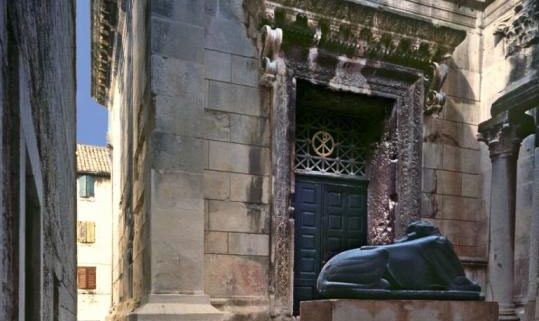
Temple Of Jupiter
Eminent Scottish architect Robert Adam considered this temple one of the most beautiful European monuments. Rectangular in its floor plan the temple served to celebrate the Jupiter’s cult. It lies on an elevated podium, with a six column porch in front of it. Embossed images on the portal, as well as the barrel coffered vault influenced the early Renaissance architecture of Andrija Alessi and Nikola Firentinac in Trogir.
The transformation into a Baptistery happened in the Late Antiquity era, with a construction of a crypt under the building dedicated to St Thomas. In the former temple, at the beginning of the 13th century, a Baptismal Font was made of the altar screen pluteus (11th century), originally seated in the cathedral. One of the posts shows a figure of a Croatian king (Petar Krešimir IV or Zvonimir), making it the earliest presentation of a European king on a Medieval stone sculpture.
The Baptistery today is dominated by a Secession sculpture of St John the Baptist, whose name the temple carried after the transformation, this was the work of Ivan Meštrović, while in front of it one of several completely or partly preserved granite sphinxes was placed that Diocletian brought from Egypt. The Baptistery is open for visitors, with an entrance fee.

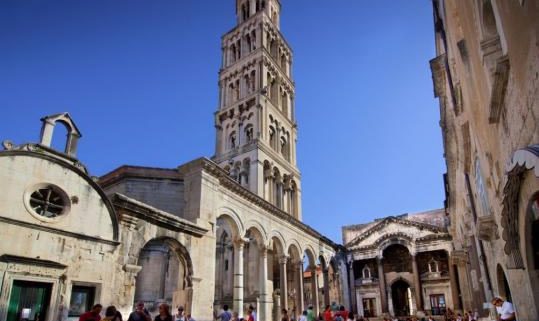
Peristyle (Peristil)
Peristyle, as the central square of the Palace, intended for the Emperor Diocletian celebrated as the living son of Jupiter, finds its place among many temples. The Emperor would appear under the architrave of the central part of Protyron, and his subjects would approach him, kneeling down, kissing the hem of his scarlet cloak, or they would fall in front of him, their entire body to the ground.
The red colour of the granite columns emphasises the ceremonial function. Namely, ever since the Emperor Diocletian the colour purple became the imperial colour. With the construction of a new city square with the town hall (Pjaca) in the 13th/14th century, Peristyle became a religious centre. Today it boarders from the West with Palaces of Split noble families Grisogono, Cipci and Skočibušić, as they lean on its authentic columns and arches. With their Renaissance and Gothic architecture they themselves became monuments.
Owing to its unique beauty and unusual acoustics, Peistyle became the ideal theatre scenery, perfect for opera classics and works of ancient literature, but also the stage where abundant urban life continues. Having your coffee on the steps circling Peristyle is a unique experience, one of the closest touches of a modern man with the ancient heritage, not only Roman, but also Egyptian, as the Peristyle is closely watched over by a 3500 old and perfectly preserved sphinx, the witness of Split’s history in making. This is why John Paul the II in amazement said ” Dear God, how many feet have stepped through here”, and this is why citizens of Split think of Peristyle as the centre of Split and the entire world.

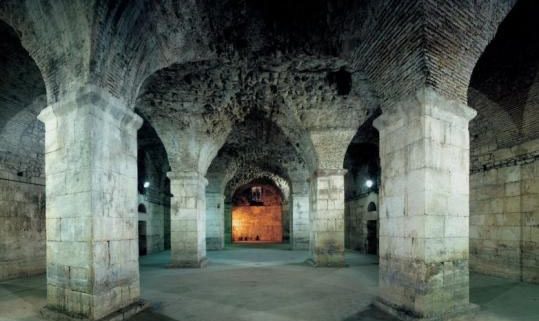
The Substructures
The Diocletian Palace Substructures represent one of the best preserved ancient complexes of their kind in the world, and hence are in many ways responsible for the reason the historical core of Split was in 1979 included on the UNESCO’S World Heritage list.
In the Roman times, their function was to elevate the Emperor’s chambers on the floor above, but they were also the storage area for the Palace. Being structurally a faithful replica of the chambers above, they enable a faithful reconstruction of the way the Emperor’s chambers looked like.
In the early Middle Ages a part of them was used as a residential area, and in one of the halls parts of an ancient oil and wine press (turnjačica) were found, remaining exhibited in the same spot to this day. With the residence construction within the Palace, the Substructures were turned into a waste pit for those households built above them. Cleaning of the Substructure’s halls was conceived and commenced in the mid 19th century by an architect Vicko Andrić, the first Split and Croatian conservationist, and today they have been excavated and reconstructed to the sixties of the last century. Only the eastern part became open for the public relatively recently, in May 1995.
The entrance to the halls of the Substructures today is through Porta Aenea, from the Riva, or down the stairs from the Peristyle. Today the Substructures are full of life. They regularly host painting and sculpture exhibitions, theatre plays, fairs like the International Flower Fair, gastronomic and oenological presentations, and many other social and cultural events. The central hall, representing the main communication line between the Riva and the Peristyle, is a place to buy valuable souvenirs, and the rest of the Substructures is open for sightseeing as one of the greatest attractions of Split, frequently, besides Peristyle, a synonym for Diocletian Palace.


 English
English Hrvatski
Hrvatski Deutsch
Deutsch Italiano
Italiano
